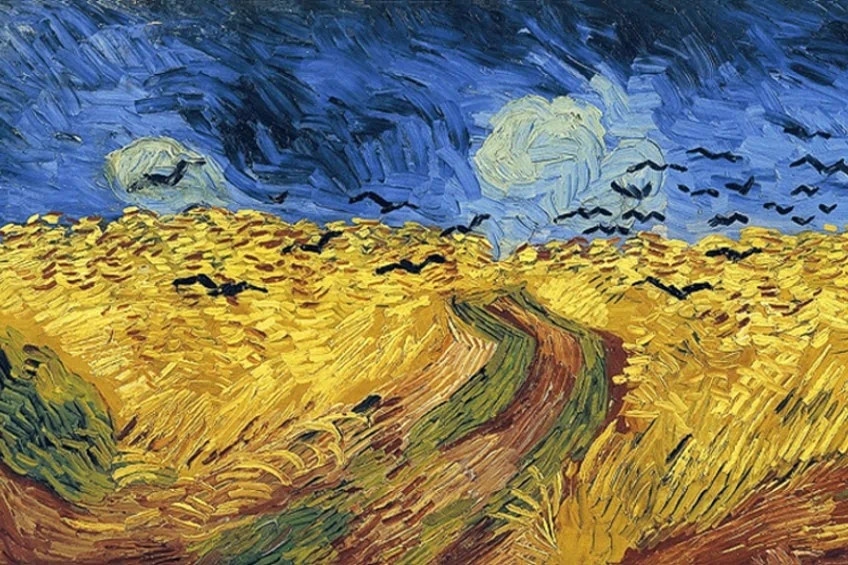Post-Impressionism – Discover the World of Post-Impressionism Art
Art movements generally emerge out of a period of stagnancy and are usually driven by a need for change. The progression from a realistic, traditional depiction of real-world imagery to the prioritization of human emotion and the artist’s unique perspective and style marked the movement you may identify as post-Impressionism. Before this, Impressionism moved one step away from the traditional ideals of representation as seen in the academy towards the depiction of real-world subjects as seen through the impression of the artist, captured with the realistic nature of subjects, as they appeared. This article will take you through the art movement known as post-Impressionism that followed Impressionism and introduce you to a few examples of post-Impressionism in art.
Contents
- 1 What Is Post-Impressionism?
- 2 Post-Impressionist Artists
- 3 Famous Post-Impressionist Paintings
- 3.1 Boy in a Red Vest (1888 – 1889) by Paul Cézanne
- 3.2 The Starry Night (1889) by Vincent van Gogh
- 3.3 The Circus (Cirque) (1891) by Georges Seurat
- 3.4 Tahitian Women on the Beach (1891) by Paul Gauguin
- 3.5 At the Moulin Rouge (1892 – 1895) by Henri de Toulouse-Lautrec
- 3.6 Large Interior with Six Persons (1897) by Jean-Édouard Vuillard
- 4 The Significance of Post-Impressionism in Art
- 5 Frequently Asked Questions
What Is Post-Impressionism?
Post-Impressionism refers to the French art movement that emerged between 1886 and 1905, which focused on the depiction of light and color in art as conveying more feeling and thus is understood as a transitory movement away from naturalistic depictions. The movement is defined by certain characteristics that make the artwork “post-Impressionistic” and which emphasize symbolic content, abstract elements, and the purpose of art to “make people feel things” as opposed to the mere representation of a subject.
Post-Impressionism as a term was coined by art critic and English painter Roger Fry in around 1906.
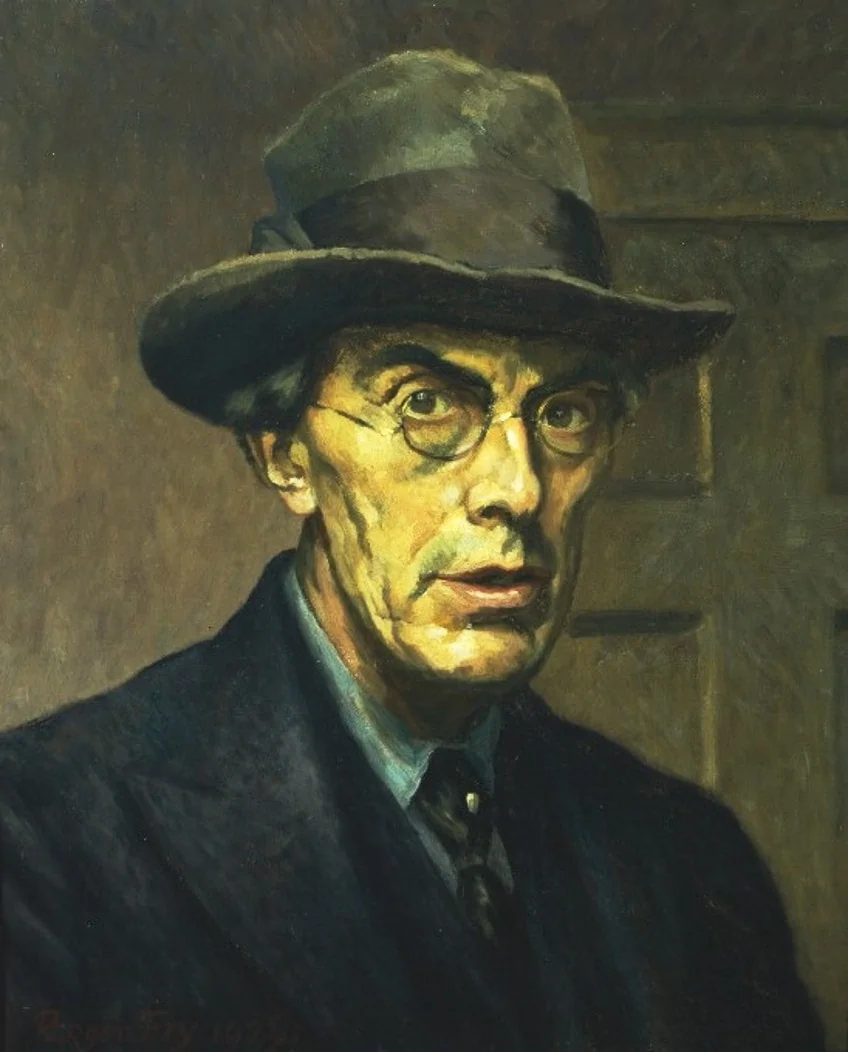
The term was also mentioned in 1910 in a Salon review that was published in Art News, which referenced Fauvist artist, Othon Friesz as a “post-Impressionist leader”. Given that Impressionism was the predecessor of this art movement, post-Impressionism was used by art critics to refer to artists who seemed to move away from the confines of Impressionism through specific characteristics, as outlined below.
Post-Impressionism Characteristics
The ideals of Impressionism can be seen as a rejection of tradition but the rejection of Impressionism by a group of artists such as Paul Cezanne, Vincent van Gogh, Paul Gauguin, and Georges Seurat marked the rise of art defined by new characteristics. One can interpret post-Impressionistic work as being the flexible version of Impressionism. Below, you will find some examples of art that showcase defining post-Impressionism characteristics.
Vivid Colors
One of the defining characteristics of post-Impressionist art is the presence of vivid colors. Madame Roulin Rocking the Cradle (1889) by famous post-Impressionist artist Vincent van Gogh (1853 – 1890), is an excellent example among many for its use of vivid color in depicting Augustine Roulin, the wife of the artist’s dear friend, the postmaster of Arles. In an unnatural display, Van Gogh uses yellow to illustrate the woman’s skin, contrasted with the bold dark outlines and the woman’s black top.
Van Gogh’s use of vivid colors in many of his works is also what helped define his own style, setting him aside from the traditional, “boring” representations and portraiture artists.

Cloisonnism
Cloisonnism is a distinct art style that emerged from post-Impressionism and is considered a characteristic of post-Impressionist artwork. The art style, Cloisonnism, was created by Louis Anquetin and Émile Bernard, both French artists who invented this style based on Japanese woodblock prints and stained glass.
The name of the style was coined by Édouard Dujardin, an art critic who derived the name from a technique called cloisonné, which referred to metalwork that contained colorful glass in wireframes.
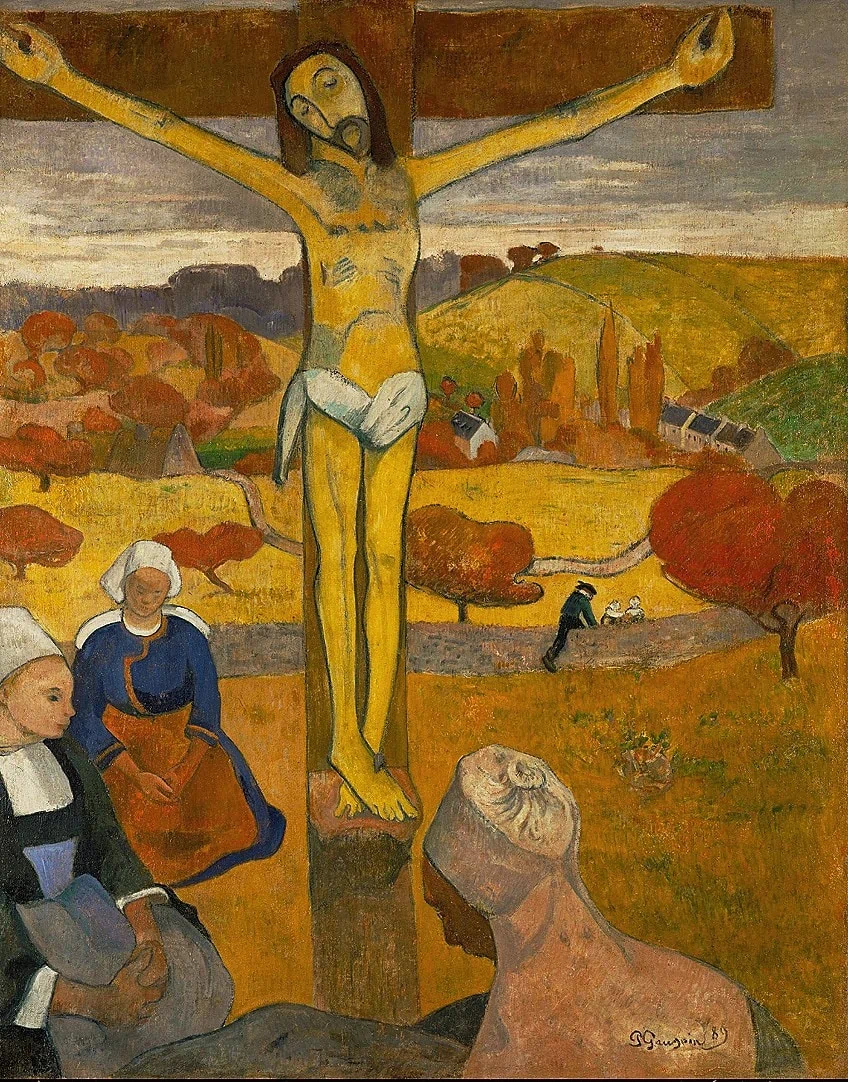
The art style is defined by the appearance of flat colors with dark lines. The Yellow Christ (1891) by Paul Gauguin (1848-1903) showcases these characteristics and is highlighted in Jesus’ flat yellow skin. Gauguin also outlines Jesus’ body using a dark line to draw attention to the main subject.
The colors are also exaggerated, further solidifying the painting’s place as a post-Impressionist painting.
Texture via Impasto
Another burst of contrasting color combinations, Van Gogh was also known to employ the impasto painting technique, which is also considered one of the post-Impressionism characteristics. Although not a primary characteristic, Van Gogh’s persistent use of the thick application of paint, coupled with bold contrasting colors, carried more feeling and emotion into his paintings. Another painting by Van Gogh, Wheatfield with Crows (1890), features contrasts such as the yellow-orange wheat with the blue sky and the red sandy path, intercepted by the green grass.
Van Gogh’s unique style of painting focused more on the movement of the scene, which evoked the nature of the scene as opposed to the mere representation of a field.
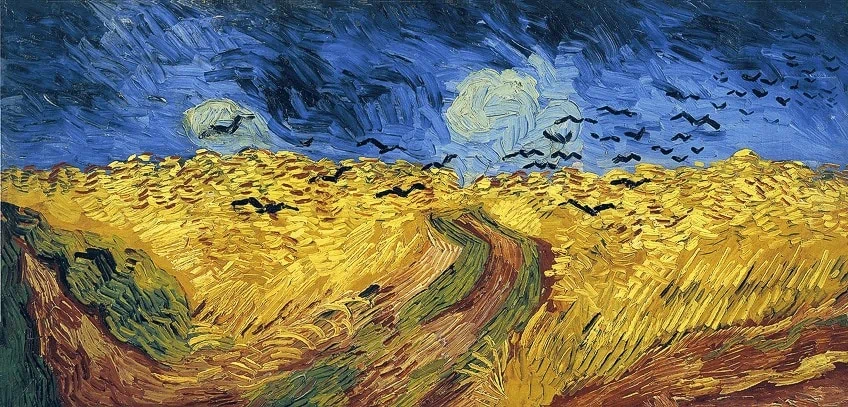
Other Post-Impressionism Characteristics
In addition to the perseverance of flat colors, abstraction, geometric forms, symbolism, prominent outlines, and expressive colors, other post-Impressionism characteristics include patterned brush strokes, distorted forms, and unnatural (modified) colors. When formulating a post-Impressionism definition, it is important to consider the above characteristics as this is what makes up the post-Impressionism definition.
We can therefore settle on post-Impressionism as defined by the presence of defined outlines, vivid colors, the use of texture to create form, and art styles that strayed from traditional representation techniques such as Cloisonnism and Pointillism.
Post-Impressionist Artists
Now that we have covered some of the main characteristics of post-Impressionism art, we can now take a look at some of the most famous post-Impressionist artists who are not only considered the pioneers of different post-Impressionist styles but are also some of the most influential artists to date.
Paul Cézanne (1839 – 1906)
| Artist Name | Paul Cézanne |
| Nationality | French |
| Date of Birth | 19 January 1839 |
| Date of Death | 22 October 1906 |
| Place of Birth | Aix-en-Provence, France |
| Art Movements, Styles, Themes | Post-Impressionism, Fauvism, Modernism, Cubism, Impressionism, landscape painting, portraiture, figure drawing |
| Mediums | Oil painting, drawing |
Greatly influenced by Romanticism, Paul Cézanne is a name well known across art history. Cézanne is said to be one of the founders of post-Impressionism as well as the leader in bridging the gap between the 19th century age of Impressionism to the 20th century age of Cubism. In addition to leading the post-Impressionism movement, Cézanne is also regarded as the “father of modernism” and “forefather of Fauvism”.
It can therefore be said that Cézanne definitely holds the title of being one of the most prolific figures in art history.
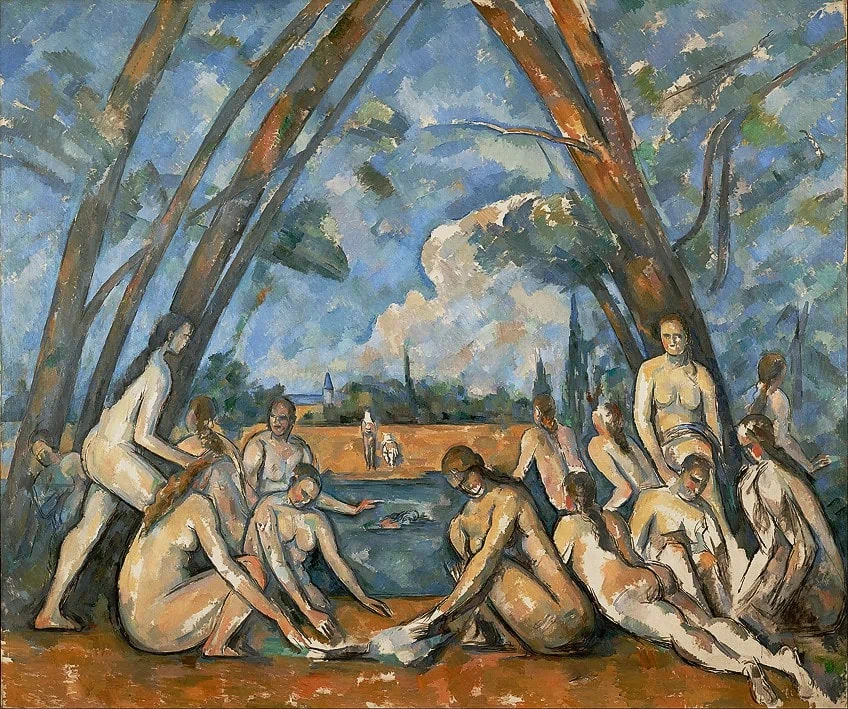
Paul Gauguin (1848 – 1903)
| Artist Name | Eugène Henri Paul Gauguin |
| Nationality | French |
| Date of Birth | 07 June 1848 |
| Date of Death | 08 May 1903 |
| Place of Birth | Paris |
| Art Movements, Styles, Themes | Post-Impressionism, Synthetism, landscape painting, Symbolism, Cloisonnism, Primitivism, pastoral |
| Mediums | Oil painting, wood engravings, woodcuts, writing, printmaking, sculpture |
Paul Gauguin experimented with color as a move away from Impressionism and was famous for adopting the Synthetic style, which was a term used to separate the post-Impressionistic work from the Impressionists. Gauguin was also known to be an influential figure to Van Gogh who greatly admired the artist’s work.
Gauguin was also influenced by folk art and Japanese woodblock prints, which helped propel his painting style towards Cloisonnism.
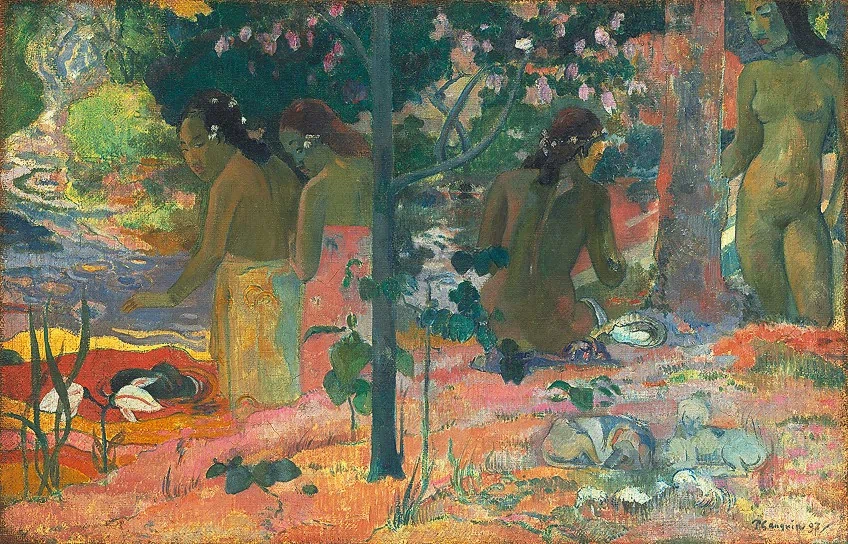
As for Gauguin’s techniques, he employed a painting technique called peinture à l’essence, which involved draining the oil from paint and using the remaining pigment to form a new mixture with turpentine and help achieve a matt finish. Gauguin also employed experimental techniques when it came to his woodblock engravings for prints where he produced many detailed illustrations containing vivid colors and broad tonality.
Vincent van Gogh (1853 – 1890)
| Artist Name | Vincent Willem van Gogh |
| Nationality | Dutch |
| Date of Birth | 30 March 1853 |
| Date of Death | 29 July 1890 |
| Place of Birth | Zundert, Netherlands |
| Art Movements, Styles, Themes | Post-Impressionism, still lifes, portraiture, self-portraiture, landscapes |
| Mediums | Oil painting, drawing, watercolor painting |
Vincent van Gogh was just as important to the recognition of post-Impressionist art as his contemporary, Paul Cézanne. It can be said that Van Gogh fought for his style, having faced many encounters in art academies with teachers and art specialists who did not agree with his approach to representation.
Van Gogh was more concerned with one of the classic elements of post-Impressionist art, that was, to capture the emotion and feeling of the subject rather than the photographic representation of the sitter.
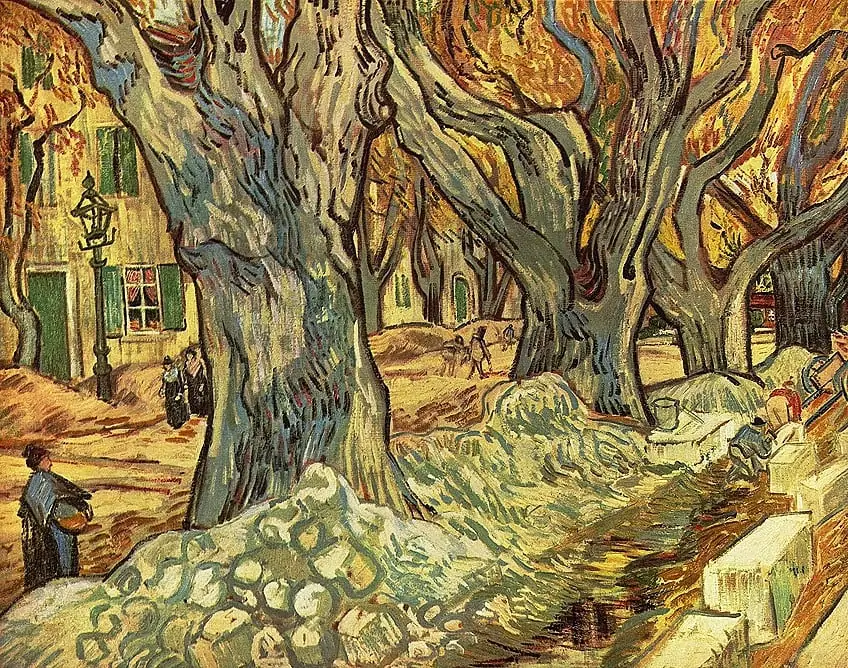
During his last few years in Arles, his style evolved and Van Gogh also drew inspiration from the Japanese art form called ukiyo-e, which encompassed woodblock prints that depicted scenes from landscapes, female beauties, sumo wrestlers, and traditional iconography of 17th and 19th-century Japan.
Georges Seurat (1859 – 1891)
| Artist Name | Georges Pierre Seurat |
| Nationality | French |
| Date of Birth | 02 December 1859 |
| Date of Death | 29 March 1891 |
| Place of Birth | Paris, France |
| Art Movements, Styles, Themes | Post-Impressionism, Chromoluminarism, Pointillism, Neo-Impressionism |
| Mediums | Oil painting, drawing |
Another great pioneer of post-Impressionist art and a major contributor to the development of new art styles such as Pointillism and Chromoluminarism, Georges Seurat is a name to remember. Seurat is described as an artist who had a passion for logical abstraction fueled by his almost “mathematical precision” toward art.
Although founded by Seurat, the art movement Neo-Impressionism was first referenced by an art critic, Félix Fénéon in 1886, after the release of Seurat’s first masterpiece, A Sunday Afternoon on the Island of La Grande Jatte (1884 – 1886).
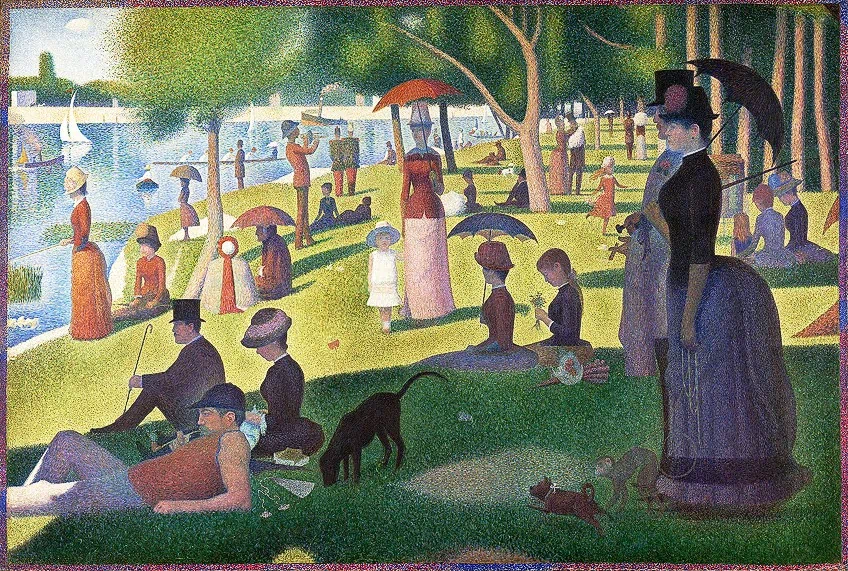
It was here that Seurat also developed the Chromoluminarism style, also known as divisionism. Chromoluminarism is characterized by separating colors into multiple dots and groups that conversate optically. This technique in painting is also known as Pointillism, which refers to the application of small dots in patterns to create an image.
Henri de Toulouse-Lautrec (1864 – 1901)
| Artist Name | Henri-Marie-Raymonde de Toulouse-Lautrec-Monfa |
| Nationality | French |
| Date of Birth | 24 November 1864 |
| Date of Death | 09 September 1901 |
| Place of Birth | Albi, France |
| Art Movements, Styles, Themes | Post-Impressionism, Art Nouveau |
| Mediums | Painting, caricature, printmaking, illustration |
Henri de Toulouse-Lautrec was a French aristocrat and artist who helped propel the lithograph as a medium into the high art sphere. Toulouse-Lautrec was therefore at the forefront of the beginning of modern printing alongside the Parisian nightlife, which inspired many of his paintings. From childhood, Toulouse-Lautrec faced health issues that at one point kept him bedridden. He took to drawing and received training from René Princeteau, a family associate who was also famous for equestrian paintings.
Unfortunately, Toulouse-Lautrec was unable to walk in his adolescence due to two accidents that left him with broken legs.

Toulouse-Lautrec later became the go-to poster artist of the late 19th century, depicting scenery from brothels, including prostitutes, popular local entertainment personalities, and other individual performers. Toulouse-Lautrec is considered one of the leading post-Impressionist artists, alongside Van Gogh, with whom Toulouse-Lautrec also shared some form of artistic educational influence.
Both Van Gogh and Toulouse-Lautrec received guidance from academic painters Léon Bonnat and Fernand Cormon.
Jean-Édouard Vuillard (1868 – 1940)
| Artist Name | Édouard Vuillard |
| Nationality | French |
| Date of Birth | 11 November 1868 |
| Date of Death | 21 June 1940 |
| Place of Birth | Cuiseaux, Saône-et-Loire, France |
| Art Movements, Styles, Themes | Post-Impressionism, |
| Mediums | Painting, printmaking |
Another prominent French artist, Jean-Edouard Vuillard, was also a member of a group of artists called les Nabis (1888 – 1900), who played a major role in the transition away from the academic styles and Impressionism toward more abstract forms and symbolism, characteristic of post-Impressionist art.
Vuillard was also known to be a decorative artist who provided designs for stained glass and plates.
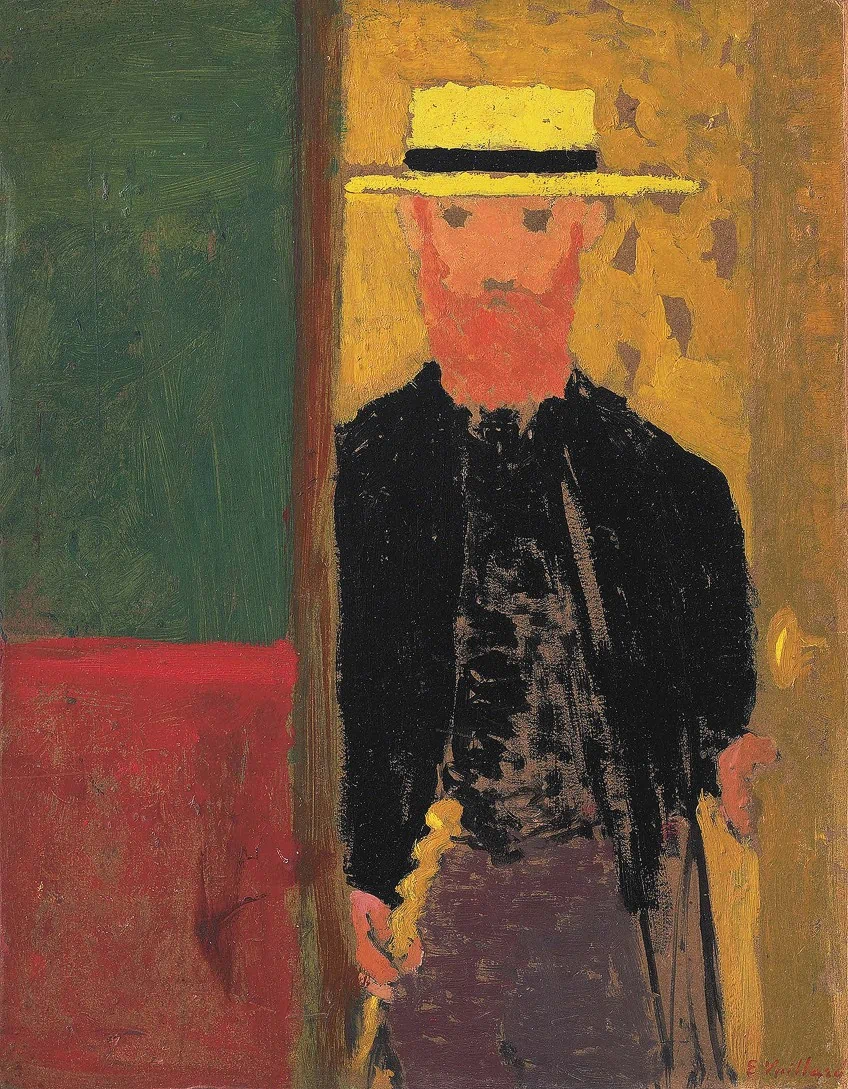
His paintings featured interior scenes, pure color, and evidence of the influence of Japanese prints. Vuillard’s primary source of inspiration during the post-Impressionist period was Paul Gauguin. According to his philosophy, Vuillard viewed painting as “a set of relations…detached from any idea of naturalism”.
Famous Post-Impressionist Paintings
Post-Impressionism was a pivotal art period that transformed the art sphere from its focus on rigid and finite subjects to a broader revolutionary movement that encompassed art as we know it today. Below, we will explore a few famous post-Impressionist paintings by the artists mentioned above.
Boy in a Red Vest (1888 – 1889) by Paul Cézanne
| Date | 1888 – 1889 |
| Medium | Oil on canvas |
| Dimensions (cm) | 81 x 64 |
| Where It Is Housed | Foundation E.G. Bührle |
Boy in a Red Vest was painted between 1888 and 1889 by Cézanne who after his experimental phase, turned towards more serious subjects for painting. The painting is also referred to as Boy in a Red Waistcoat and is a great example of his work as a post-Impressionist painter.
While there is less focus on the details of the boy’s facial features, more care was taken in the depiction of light and the use of cooler tones to amplify the morose, perhaps gloomy, and somber mood of the boy who appears lost in deep contemplation.

The light falls on his sleeve and his head, which helps narrow in on the main focus of the painting. Even without the attention to a realistic depiction, Cézanne skillfully uses the placement of color and darkened outlines to deliver this post-Impressionistic painting.
The Starry Night (1889) by Vincent van Gogh
| Date | 1889 |
| Medium | Oil on canvas |
| Dimensions (cm) | 74 x 92 |
| Where It Is Housed | The Museum of Modern Art |
Perhaps one of the most iconic and widely distributed images in art history, and certainly the most popular of the post-Impressionistic artist Van Gogh is The Starry Night (1889). This is a classic example of one of the most famous post-Impressionist paintings.
The painting shows Van Gogh’s depiction of the night sky from the painter’s asylum room window at Saint-Rémy-de-Provence.

The village in the background is completely imaginary and this too adds to the innovative nature behind post-Impressionist paintings. The inclusion of the imaginary suits the dream-like painting style of Van Gogh and it has also left a huge impact on art history as a prime example of the emergence of modern art.
The Circus (Cirque) (1891) by Georges Seurat
| Date | 1891 |
| Medium | Oil on canvas |
| Dimensions (cm) | 152 x 185 |
| Where It Is Housed | Musée d’Orsay, Paris, France |
The theme of the circus was often portrayed in the works of other artists such as Renoir and Toulouse-Lautrec. In The Circus (1891) by Georges Seurat, the application of divisionist theory is expertly applied in conjunction with the use of line and the optical combination of complementary colors that create a speckled effect.
The painting is said to remain unfinished, however, its direction in Neo-Impressionism was visually evident through its use of pointillist dots.
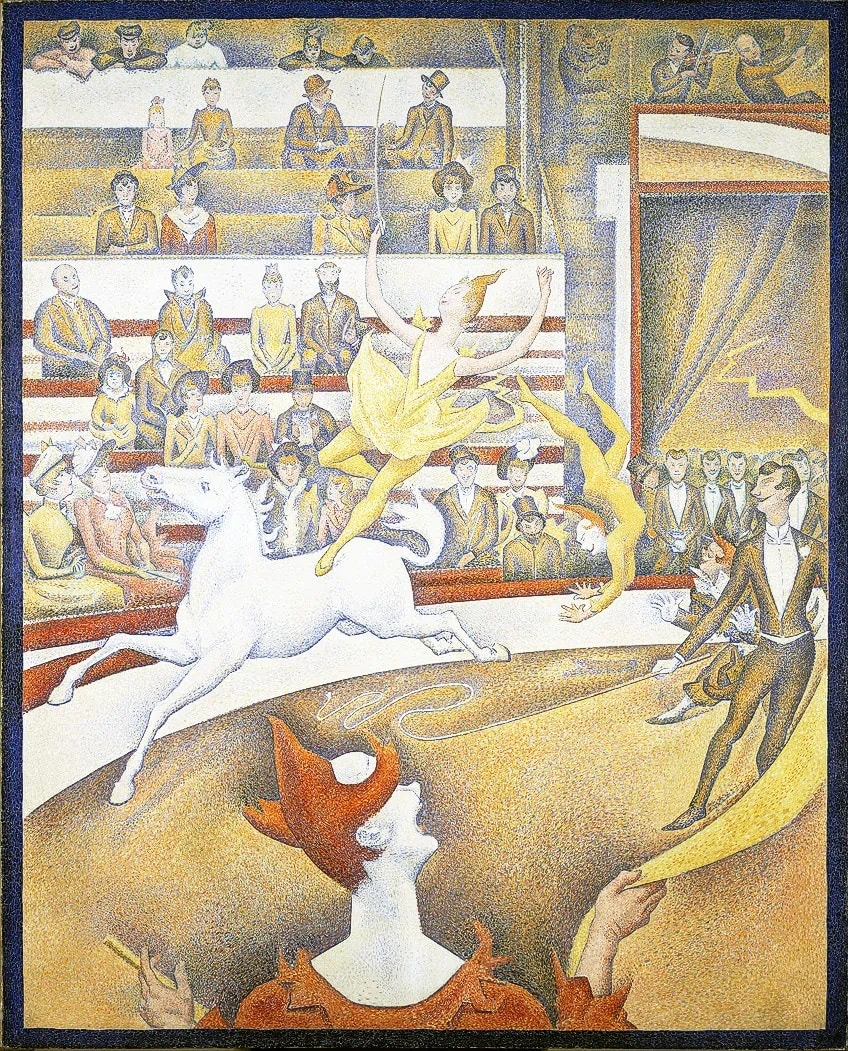
The Circus was first exhibited to the public in March of 1891 at the Salon des Indépendants, where an art critic described the painting as having achieved a sense of harmony via analogy and the “conciliation of opposites, conspiring towards a sense of gaiety”, as illustrated by the dominance of the color orange, the tonal contrasts, the ascending lines, and the frame, which highlights “an opposition of tone and color with the whole”.
Tahitian Women on the Beach (1891) by Paul Gauguin
| Date | 1891 |
| Medium | Oil on canvas |
| Dimensions (cm) | 69 x 91 |
| Where It Is Housed | Musée d’Orsay, Paris, France |
In Tahitian Women on the Beach (1891), Paul Gauguin applies a two-dimensional synthetism approach to painting as he depicts two Tahitian women sitting on the sand. It is important to note, as with many other post-Impressionist paintings, that the subjects are not shown as they were. This means that Gauguin applied one of the characteristics of post-Impressionist art – distortion of form.
The faces of the women draw more resemblance to masks than actual facial features and all the colors seem to be separated by distinct dark lines.
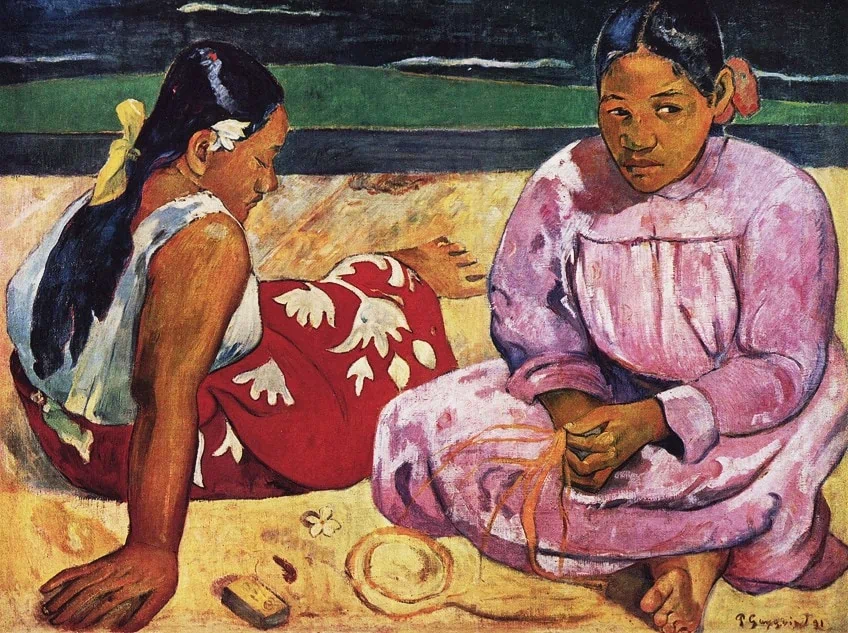
The women are contrasted by the lighter yellow sand they sit on while the background contains the green water and the black sea, highlighted by the addition of white to show the glistening waves. Gauguin’s painting also showcases the colonial influence of the West on Polynesian society while highlighting a specific duality in the women and the calmness of the background.
At the Moulin Rouge (1892 – 1895) by Henri de Toulouse-Lautrec
| Date | 1892 – 1895 |
| Medium | Oil on canvas |
| Dimensions (cm) | 123 x 140 |
| Where It Is Housed | Art Institute of Chicago |
Painted between 1892 and 1895, At the Moulin Rouge showcases the atmosphere of the Parisian Moulin Rouge cabaret through its splendid display of color in blue, green, and red hues. In the painting, one can see a group of three men sitting at a table with two women.
The people at the table include the likes of Édouard Dujardin (a French writer), La Macarona (a dancer), Jane Avril (a French can-can dancer), and Paul Secau and Maurice Guibert (photographers).
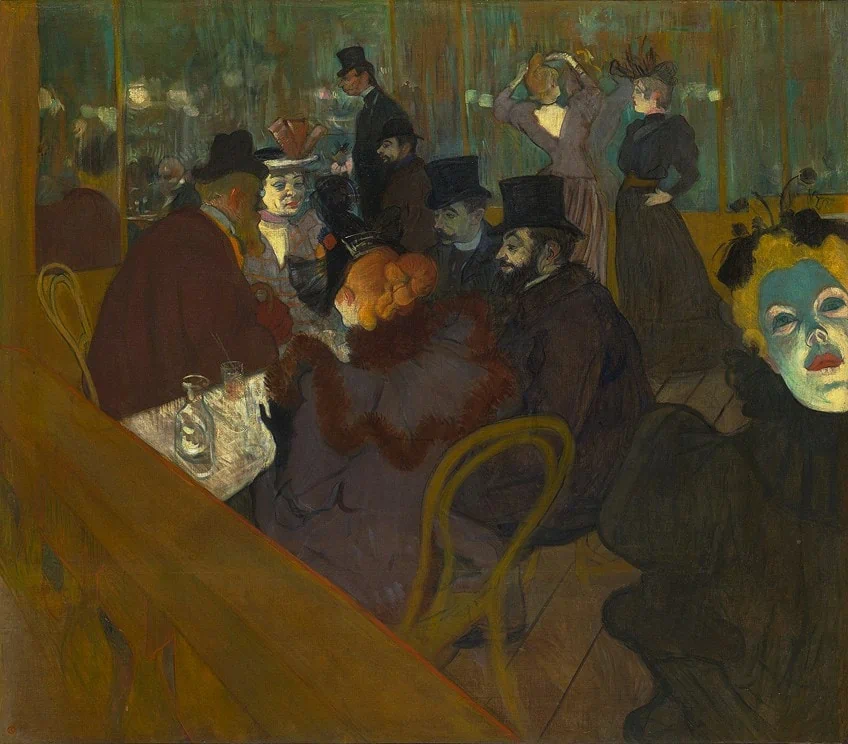
Also featured in the background are May Milton, an English dancer whose face appears to glow with a greenish hue; La Goulue, a Moulin Rouge dancer; and the artist himself, Toulouse-Lautrec, standing close to Dr. Gabriel Tapié de Céleyran.
Large Interior with Six Persons (1897) by Jean-Édouard Vuillard
| Date | 1897 |
| Medium | Oil on canvas |
| Dimensions (cm) | 90 x 194.5 |
| Where It Is Housed | Kunsthaus Zürich |
Like many of his interior paintings, Vuillard strategically used color and perspective to capture the personalities of each sitter in a room. This work in particular, Large Interior with Six Persons (1897) was a memorable scene for Vuillard considering that the situation involved an affair between Germaine Rousseau and Kerr-Xavier Roussel, who was Vuillard’s brother-in-law.
It is unclear why Vuillard chose to paint perhaps the moments before the meeting about the scandal.
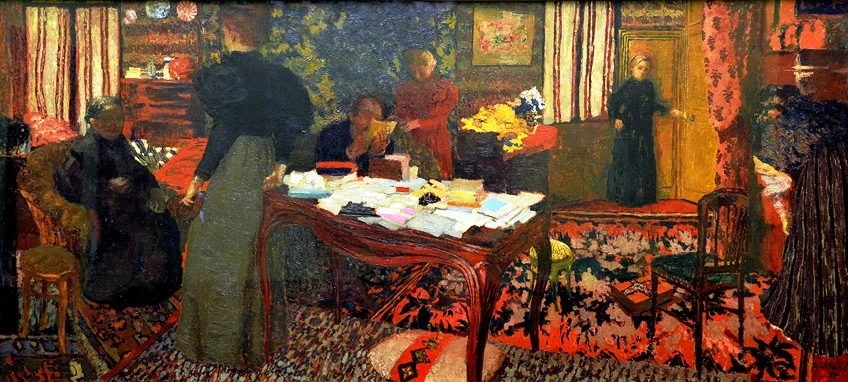
His display of post-Impressionist painting style is evident in his ability to use warmer colors to create relationships between all the subjects in the painting. Prominent textures such as the orange hue of the carpet, the sienna of the wooden furniture, and the contrast of the black clothing on the subjects make the painting “pop”.
The Significance of Post-Impressionism in Art
Now that you have gotten a better grasp of the different ways that post-Impressionism showed up in art and the artists who helped propel this art movement, we will now discuss the significance of post-Impressionism. The move away from traditional representation also marked the move away from traditional interpretation.
A picturesque landscape or technically brilliant, life-like portrait is never just as it appears in post-Impressionistic art.
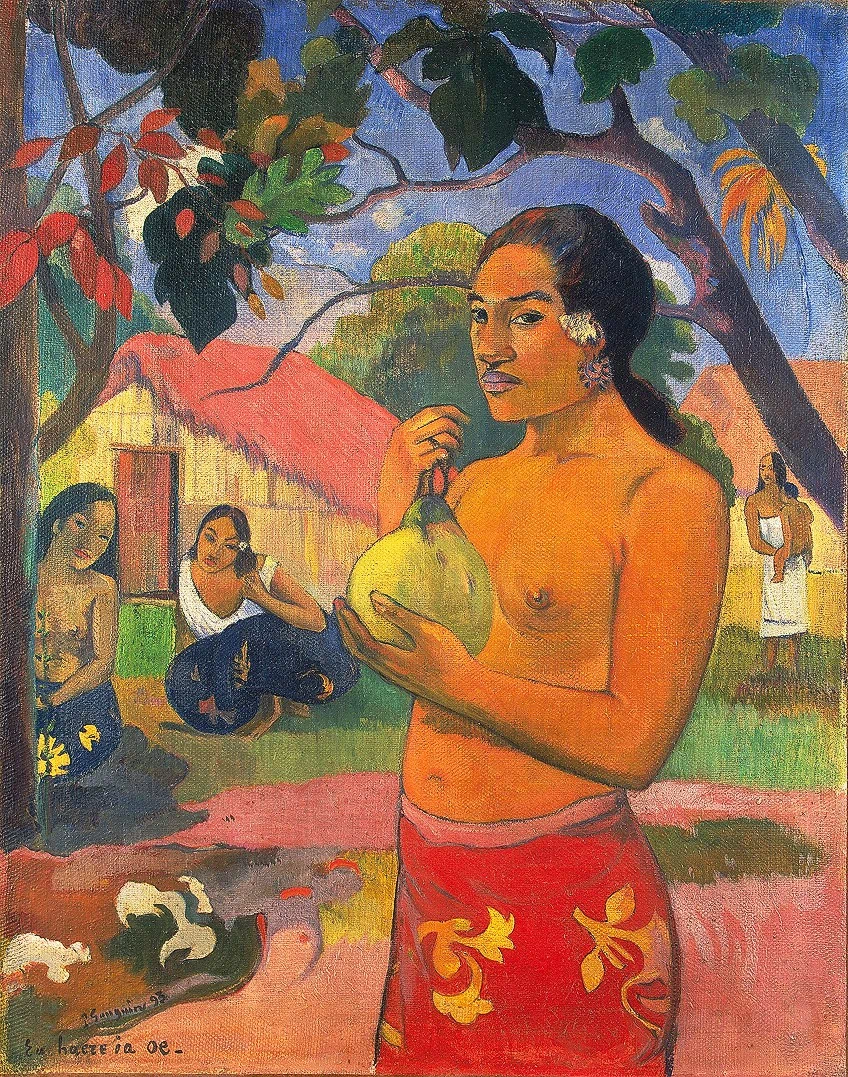
Take for example the work of Van Gogh and his self-portraits. Below is just one self-portrait out of many that you may view initially as simply a self-portrait painted through the lens of his unique style. While this may be a very broad, single-minded viewpoint, a self-portrait made during the height of post-Impressionism carried the power to transform the way that we interpret the self, through the lens of the artist and gives us not only a glimpse into the physical representation of an artist but a glimpse into his soul.
Many post-Impressionist artists were fully aware of the transformative nature of their works; therefore, they pursued their fight toward modernity.
This brings us to another point of importance regarding post-Impressionism, that is, post-Impressionism was the beginning of art history’s long-winded affair with modernity. When we refer to modernity here, we refer to the genre of art that is unbound by the traditional forms of representation and an era of art that encourages experimentation.
Understanding the Transition
There is also the distinction created between Impressionism and post-Impressionism that is useful to understand the difference between the latter movements. While Impressionism focused on capturing a visual impression of a moment, the post-Impressionists decided to capture the emotion behind the moment, along with the visual impression.
The best way to visualize the difference between the two art movements and what this transition meant is to observe the difference in the painting styles.
We will now take a look at an artwork produced during Impressionism and an artwork produced by a post-Impressionist. Below is an example of an Impressionist work by renowned Impressionist, Claude Monet as well as a self-portrait by post-Impressionist, Van Gogh. While both works are self-portraits, the style of each painting differs significantly.
Self-Portrait with a Beret (1886) by Claude Monet
| Artist Name | Claude Monet |
| Date | 1886 |
| Medium | Oil on canvas |
| Dimensions (cm) | 46 x 56 |
| Where It Is Housed | Private collection |
Monet’s Self-Portrait with a Beret (1886) appears to retain the life-like qualities associated with skin color and the elements of the painting, as they appeared in real life. On the other hand, if you take a look at Van Gogh’s Self-Portrait with a Bandaged Ear (1889), you will find that while the style is different in brush strokes, the colors of a post-Impressionist artwork are not true to real-life representation.
Monet’s self-portrait captures himself as an image of a man, rendered in his Impressionist style.

Van Gogh’s self-portrait below does more than just represent him. Through color, it conveys the true emotion behind the artist. It is a painting that represented not who he was but also how he felt in the aftermath of a depressive episode involving self-mutilation.
Self-Portrait with Bandaged Ear (1889) by Vincent van Gogh
| Artist Name | Vincent van Gogh |
| Date | 1889 |
| Medium | Oil on canvas |
| Dimensions (cm) | 60 x 49 |
| Where It Is Housed | Courtauld Institute of Art |
The introduction of post-Impressionist artworks also meant the introduction of the artist as more than a specialist who was talented at capturing the real or imagined world in technical splendor. It also meant that the public was now able to catch a glimpse into the reality of the artist as an individual.
One can perhaps say that the post-Impressionist era contributed to the humanization of the artist, and the acceptance of art as a means of self-expression.
Like all great art movements, post-Impressionism was also sparked by the rejection of the former trend in a play with light and color presented by Impressionism. Post-impressionism has also been heavily criticized for its unfinished nature and “child-like” aesthetic. The unique variations on the combination of art elements such as texture, form, and color play a role in defining some of the greatest post-Impressionist artworks.
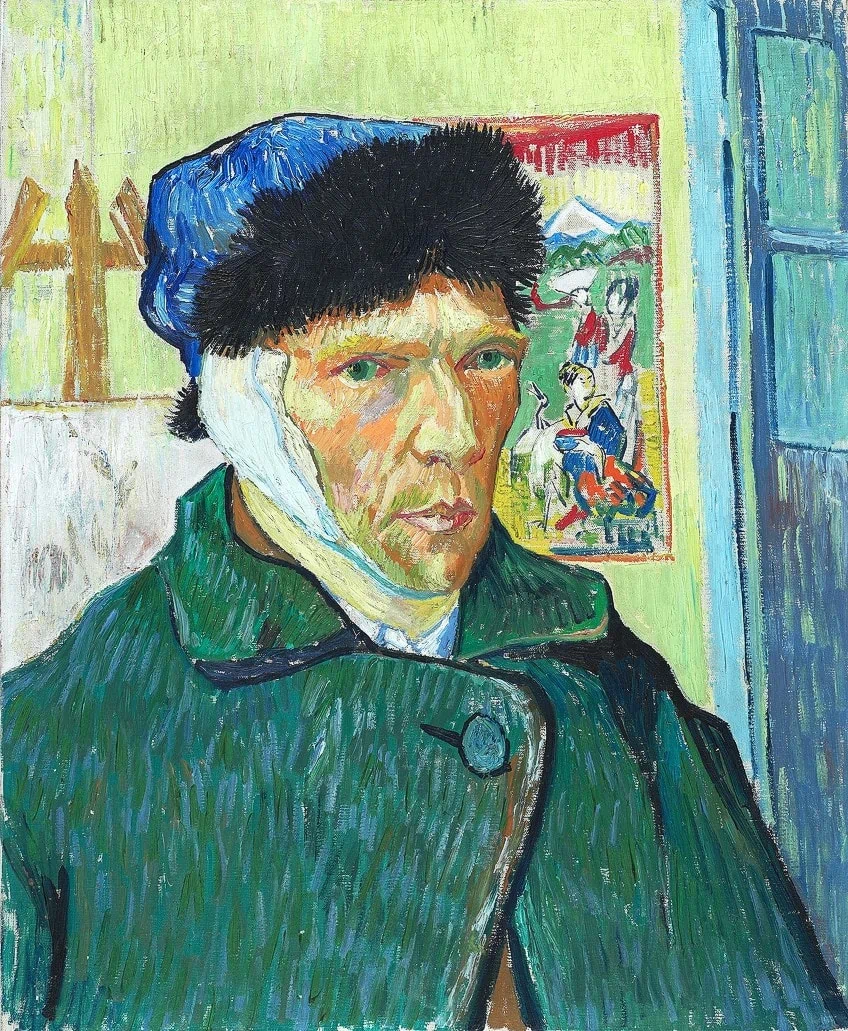
Some other examples of famous post-Impressionist artworks include Couple in the Street (1887) by Charles Angrand, Bedroom in Arles (1888) by Vincent van Gogh, Spirit of the Dead Watching (1892) by Paul Gauguin, and Femme au Chapeau Vert (1895) by Paul Cézanne. Another great aspect of post-Impressionist art is that the artists of the time also wished to emphasize the form and structure of their works to “sculpt it” rather than let the subject fade into the background.
Post-Impressionists not only focused on light and color but also on form and structure. Artists such as Cézanne used defined brush strokes with minimal emphasis on the blending of colors as a key characteristic of his style.
The inclusion of defined outlines is one way of identifying a post-Impressionist artwork and distinguishing it from an Impressionist style. Abstraction in post-Impressionism is used to highlight objects or subjects through color and appears defined enough to recognize the subject but not as detailed as an Impressionist work.
Post-Impressionism is one of the most important art movements that paved the way for freedom of artistic expression away from the rigidity of traditional academic beliefs towards art techniques and what makes an artwork good enough for inclusion in the Salon. Some other great post-Impressionists to look into include Paul Signac, Henri Rousseau, Edvard Munch, Pablo Picasso, and Nils Dardel.
Take a look at our what is Post-Impressionism webstory here!
Frequently Asked Questions
What Is Post-Impressionism?
Post-Impressionism is defined as the period in art history during late 19th-century France where a group of artists chose to create their own interpretation of reality as a rejection of the ideals of Impressionism, which focused on naturalistic depictions. Post-Impressionism focuses on color, light, form, and structure while integrating more emotion into artwork and placing emphasis on the feeling evoked from a moment as opposed to the visually realistic depiction of a subject.
What Are the Characteristics of Post-Impressionism Art?
A few characteristics of post-Impressionist work include the presence of vivid colors, stark outlines, a visual aesthetic that appears unfinished or incomplete, the inclusion of painting techniques such as impasto for an emphasis on form and texture, Pointillism, and Cloisonnism.
What Is the Most Famous Post-Impressionist Painting?
The Starry Night (1889) by Vincent van Gogh is regarded as the most famous post-Impressionist painting, followed by Paul Cézanne’s The Card Players series of the early 1890s and A Sunday Afternoon on the Island of La Grande Jatte (1884 – 1886) by Georges Seurat.
Who Were the Pioneers of Post-Impressionism?
The leaders of post-Impressionism movement are considered to be Paul Cézanne, Paul Gauguin, Vincent van Gogh, Georges Seurat, Paul Signac, Henri de Toulouse-Lautrec, and Henri Rousseau.
Jordan Anthony is a Cape Town-based film photographer, curator, and arts writer. She holds a Bachelor of Art in Fine Arts from the University of the Witwatersrand, Johannesburg, where she explored themes like healing, identity, dreams, and intuitive creation in her Contemporary art practice. Jordan has collaborated with various local art institutions, including the KZNSA Gallery in Durban, the Turbine Art Fair, and the Wits Art Museum. Her photography focuses on abstract color manipulations, portraiture, candid shots, and urban landscapes. She’s intrigued by philosophy, memory, and esotericism, drawing inspiration from Surrealism, Fluxus, and ancient civilizations, as well as childhood influences and found objects. Jordan is working for artfilemagazine since 2022 and writes blog posts about art history and photography.
Learn more about Jordan Anthony and about us.
Cite this Article
Jordan, Anthony, “Post-Impressionism – Discover the World of Post-Impressionism Art.” artfilemagazine – Your Online Art Source. August 31, 2022. URL: https://artfilemagazine.com/post-impressionism/
Anthony, J. (2022, 31 August). Post-Impressionism – Discover the World of Post-Impressionism Art. artfilemagazine – Your Online Art Source. https://artfilemagazine.com/post-impressionism/
Anthony, Jordan. “Post-Impressionism – Discover the World of Post-Impressionism Art.” artfilemagazine – Your Online Art Source, August 31, 2022. https://artfilemagazine.com/post-impressionism/.


